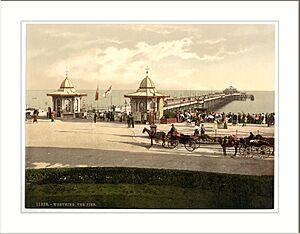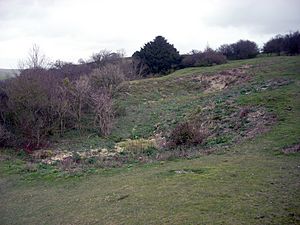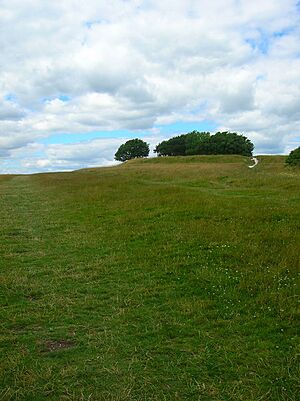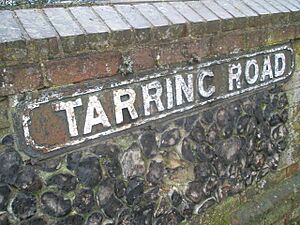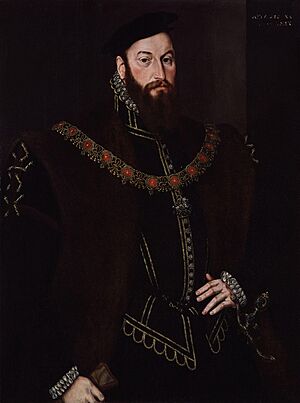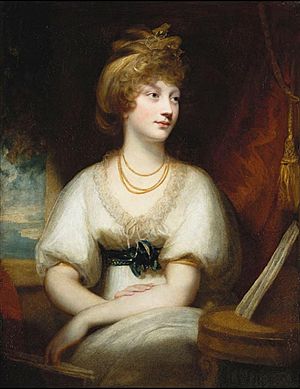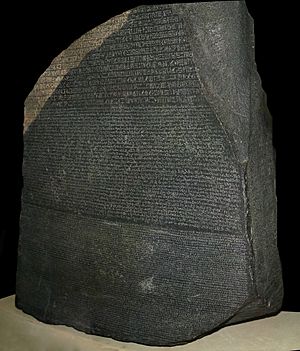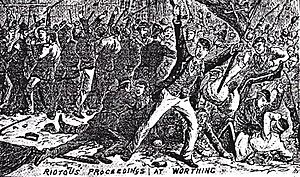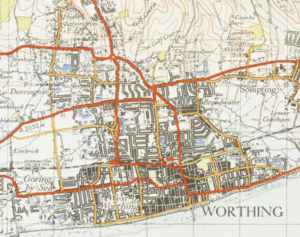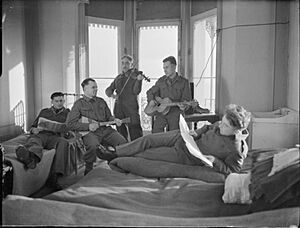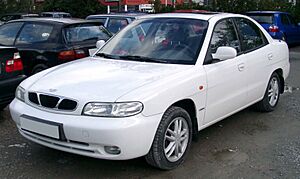History of Worthing facts for kids
Worthing is a big town by the sea in Sussex, England. Its history goes way back to prehistoric times, but it really became important in the 1800s.
Contents
Ancient Times
Stone Age Discoveries
Near Worthing, there are four of Britain's 14 known Neolithic (New Stone Age) flint mines. The oldest one, at Church Hill in Findon, might be one of the very first mines in Britain! These mines are super old, dating back to 4500 BC. That's even before famous places like Stonehenge were built.
During the Stone Age, the South Downs hills above Worthing were a huge and important place for digging up flint. This flint was very hard and strong, perfect for making tools. Flint from these mines helped people change their way of life. They stopped being nomadic hunter-gatherers and started farming, cutting down forests to grow food. Flint from Worthing was even traded across southern Britain!
The main flint mines were at Harrow Hill, Blackpatch Hill, Church Hill, and Cissbury. Cissbury, which is in Worthing, had between 100 and 200 mine shafts, making it Britain's second largest flint mine. People used the flint to make tools like axes, scrapers, and arrowheads. At Harrow Hill, many ox skulls were found, suggesting special ceremonies. In some mine shafts, drawings of an "Earth Spirit" were found, possibly to protect the mines.
It seems the area around Worthing, especially where the mines were, was a very special and sacred place in the Stone Age. People might have thought it had a high status, which continued into the Bronze and Iron Ages.
Bronze Age Settlements
Several burial mounds from the Bronze Age have been found near Cissbury on the Downs in Worthing. The enclosures at Highdown Hill are thought to have been built around this time. Finds like pottery and metalwork suggest Highdown Hill was an important settlement back then. In 1877, a big collection of Bronze Age tools and pottery was found near Ham Road in East Worthing.
Iron Age Forts
The large hill fort at Cissbury Ring was built in the middle Iron Age. It covers a huge area of 60 acres, making it one of the biggest Iron Age hill forts in Britain and Europe!
During the Iron Age, the land between the rivers Adur and Arun was still seen as a special place. Highdown Hill kept its importance, and other places like Chanctonbury and Harrow Hill might have been used for special rituals.
In 1842, a boat made from a hollowed-out oak tree was found near Heene Road. Experts believe this boat dates back to the Iron Age.
Roman Times
Roman coins, tiles, and pottery have been found all over Worthing. Some roads in the area are from the Roman era or even earlier. For example, a Roman road from Chichester to Portslade ran through Durrington and Broadwater.
It's likely that many of Worthing's roads were laid out by the Romans in a grid pattern for farming fields. Worthing's High Street is part of a very old track that goes from the South Downs all the way to the sea. This track was probably used by people moving animals. Today, you can still walk parts of it.
Many modern roads in Worthing seem to follow this old Roman grid system. For example, South Farm Road and Tarring Road (which was an ancient border between Heene and Tarring) fit into this pattern.
There's proof of several Roman buildings in Worthing. The town's Museum and Art Gallery is built where a Roman farmhouse once stood. A Roman settlement was found along Brighton Road. Remains of a Roman villa and bath house were discovered at Northbrook College's Goring campus. A Roman milepost was found in Grand Avenue, suggesting another Roman road. A Roman cemetery was found near Chesswood Road.
Just outside Worthing, there was a Roman shrine at Muntham Court. Roman villas and bath-houses also existed at Highdown and nearby Angmering. A very important collection of Roman coins, called the Patching hoard, was found in 1997. These coins were buried after 475 AD, long after the Romans left Britain around 410 AD. You can see this hoard at the Worthing Museum.
The Middle Ages
Anglo-Saxon Settlers
Around 450 AD, Highdown Hill was used as a cemetery by the South Saxons. Nearly 100 graves were found, possibly belonging to Saxon warriors. It's interesting that pagan Saxons were buried at Highdown while a Roman-British villa nearby was still used by local Christians. This suggests that the two groups lived together peacefully.
The Saxons settled in nearby Goring and Sompting. By the 1200s, the settlement known as Wortinge was mostly home to farmers and mackerel fishermen. Worthing was originally part of the bigger village of Broadwater. Other nearby villages that later became part of Worthing include Tarring, Salvington, Goring, Heene, and Durrington.
Old tracks used for moving animals, which go from Tarring, Broadwater, and Sompting to grazing areas, are thought to be from this period or even earlier.
Norman Times and Beyond
After the Norman conquest in 1066, William de Braose gave the land of Worthing (then called Ordinges) to Robert le Sauvage. His family owned Worthing for about 200 years. Worthing is first mentioned in the Domesday Book (a big survey from 1086) as two small settlements, Ordinges and Mordinges, with only 22 people. By 1218, Ordinges was known as Wurddingg.
In the 1200s, the land of Worthing was owned by Margaret de Gaddesden. She later gave the land to Easebourne Priory, a religious house. This was probably because she feared for her soul after leaving her first husband for another man.
Worthing had a chapel throughout the Middle Ages, though its exact location is unknown. It was first mentioned in 1291 and was still in use in the early 1500s. By 1635, it had been pulled down.
In 1300 and 1493, Worthing was recorded as having a harbour, possibly where the Teville stream met the sea.
The Modern Period
Early Modern Worthing
Worthing was owned by the Easebourne Priory until 1539, when King Henry VIII closed down the monasteries. Then, it became the property of Anthony Browne, 1st Viscount Montagu, whose family owned Worthing for more than 200 years.
William Penn, who founded Pennsylvania in America, landed in Worthing in 1682 to pick up people from Sussex before sailing across the Atlantic. He landed in Worthing again in 1684 on his way home. Penn even wrote "Worden" in some letters, which was how people in Sussex pronounced Worthing back then.
In the late 1700s, Worthing started to become a place for visitors. John Luther from London built a large guesthouse around 1759. In 1789, George Greville, 4th Earl of Warwick bought it and called it Warwick House. Worthing became popular because of its warm climate and calm seas, which were good for "sea cures" – a popular health trend at the time. Over the next century, Worthing became a fashionable resort, like Bath and Brighton.
The 1800s: A Popular Resort
Visits from members of the Royal Family, like Princess Amelia in 1798 and Princess Charlotte in 1807, made Worthing even more popular. Even Queen Adelaide stayed in the town in 1849.
Many famous people visited Worthing in the 1800s, including novelist Jane Austen in 1805, Lord Byron in 1806, and Oscar Wilde in 1893 and 1894. Oscar Wilde even wrote his famous play The Importance of Being Earnest while staying in Worthing!
In 1803, Worthing's population was about 2,500, and it officially became a town. A new road was built, connecting Worthing directly to Horsham and London for the first time.
In the early 1800s, a wall was built to separate fashionable Worthing from Heene to the west. This wall, along with the Teville Stream, meant there was only one easy way into and out of town. This helped keep "undesirables" out.
Worthing's first Anglican church, St Paul's, was built in 1812. Before that, people had to go to the old church in Broadwater. As the town grew, more churches opened, like Christ Church in 1840.
In 1814, a clever scientist named Thomas Young brought a copy of the Rosetta Stone to his summer home in Worthing. He studied it here and made important discoveries that helped to understand Egyptian hieroglyphs (ancient Egyptian writing).
In 1815, two schools for young children opened, thanks to the efforts of Revd. W. Davison from St Paul's Church.
In 1832, there was a big event involving smugglers. About 300 barrels of illegal spirits were unloaded on the beach. Excise officers chased the smugglers through the town's streets and alleyways. When the smugglers slowed down, the officers on horseback opened fire, killing one man and injuring others. The army had to be brought in to keep the peace. Smuggling was a common and profitable business in Sussex and Kent because they were so close to Europe.
In 1845, the railway line was extended to Worthing, connecting the town by train to London and the rest of the country.
In 1890, Worthing officially became a borough and took in the nearby areas of West Worthing and Heene. The first mayor, Alfred Cortis, was elected.
In 1893, a serious outbreak of typhoid fever caused 200 deaths. The new town council acted quickly, and by 1895, Worthing had a new drainage system to prevent such outbreaks.
The 1900s: Growth and Change
The 1900s saw Worthing continue to grow, taking in more local villages. In 1902, it expanded to include parts of Broadwater and West Tarring. In 1929, Goring and Durrington joined. And in 1933, parts of Sompting and Findon became part of Worthing.
Between 1908 and 1910, King Edward VII visited Worthing several times, staying at Beach House.
In 1933, Charles Bentinck Budd was elected to the town council. He announced he was a member of the British Union of Fascists (BUF), making Worthing the first town to elect a fascist councillor. This led to street fights, including the "Battle of South Street" in 1934, when anti-fascist protesters clashed with Blackshirts (BUF members) outside the Pavilion Theatre.
After Italy invaded Abyssinia in 1936, Emperor Haile Selassie and his family came to the UK. They stayed at the Warnes Hotel in Worthing for six weeks.
During World War II, a hole was blown through Worthing Pier to stop enemies from using it to land. Barbed wire and mines were placed on the beach. Canadian soldiers stayed in Worthing, and Courtlands, a large house in Goring, was used as the headquarters for the First Canadian Army. Food was rationed during the war. The people of Timaru in New Zealand sent food parcels to Worthing. After the war, Worthing sent a stained glass window to Timaru to say thank you.
Right after the war, Worthing expanded with the Maybridge housing estate, built between 1948 and 1956, partly using prisoner of war labour.
In the late 1900s, many of Worthing's old buildings were pulled down to "modernise" the town. This included the Theatre Royal, the Old Town Hall, and many Victorian houses.
In the late 20th century, Worthing had a significant car industry. Datsun UK (later Nissan UK) was founded in West Durrington in 1979. Dutton Cars made kit cars from Worthing, and for a while, they were the biggest kit car maker in the world! International Automotive Design (IAD) designed cars for companies like Mazda, including the first Mazda MX-5. In 1994, Daewoo bought IAD and continued to develop cars, trucks, and vans at their Worthing Technical Centre.
The 2000s: Looking Forward
In 2006, Worthing's council approved "Worthing Evolution," a plan to improve and update the town.
Since 2006, environmental protesters have been living in trees at Titnore Wood in Durrington. They are protesting against plans to build houses and widen a road through this ancient woodland.
In 2008, Worthing hosted a public meeting about the idea of creating a South Downs National Park.
In 2009, "Transition Town Worthing" (TTW) was started. This group helps the community prepare for climate change and the end of cheap oil. They encourage projects to make Worthing more self-reliant and sustainable.
See also
- Timeline of Worthing
- High Street, Worthing
- History of Sussex
- Kingdom of Sussex
- Sussex


